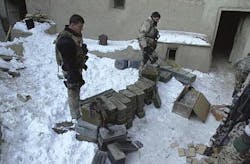Army eyes automated methods of combing through captured sites for important intelligence
ABERDEEN PROVING GROUND, Md., 20 March 2013. U.S. Army researchers say they plan to approach industry later this month for ways of automating the process of collecting analyzing, and interrogating information, material, and people captured during military operations to make the most of intelligence-gathering opportunities while keeping warfighters as safe as possible.
Officials of the Army Contracting Command at Aberdeen Proving Ground, Md., say they will issue a request for proposal (W911SR-13-R-0007) by the end of this month for the Sensitive Site Exploitation Automation for Improved Operations Capabilities Definition program.
The RFP will be on behalf of the Edgewood Chemical Biological Center (ECBC) at Aberdeen Proving Ground northeast of Baltimore, and the Defense Threat Reduction Agency (DTRA) at Fort Belvoir, Va.
Sensitive site exploitation is systematically searching for and collecting information, material, and persons from a designated location for valuable information or criminal prosecution. Exploiting a site involves capturing people, documents, computers, recordings, weapons, ammunition, equipment, chemicals, and other kinds of military supplies for analysis and interrogation to produce intelligence.
Sensitive site exploitation actually is an archaic Army term that has not been in use since 2010. The Army field manual 3-90.15 (FM 3-90.15) on Army tactics, techniques, and procedures refers to these procedures simply as site exploitation, and refer to all sites that have the potential to yield valuable information -- whether or not they are designated as sensitive.
Requirements for the future Sensitive Site Exploitation Automation for Improved Operations Capabilities Definition program will include the identification of site exploitation automation candidate technologies that can improve mobility, dexterity, system interfaces, autonomy, and communications.
The ultimate goal is to remove the warfighter from danger through advances in automation. Enemy sites that contain potentially valuable intelligence information often can be guarded by specially trained troops, improvised explosive devices (IEDs), and other methods dangerous to U.S. warfighters.
Site exploitation refers to a systematic and comprehensive approach to obtaining information of value from a site for exploitation. Valuable material may include tactical weapons, materials for making bombs, or even weapons of mass destruction, as well as evidence of war crimes or other information of strategic importance.
Site exploitation not only can lead to eliminating weapons of mass destruction, but also to attacking threat networks. The four major types of threat are traditional, irregular, catastrophic, and disruptive, Army officials say.
Traditional threats involve conventional military capabilities. Irregular threats involve unconventional methods such as terrorism. Catastrophic threats involve weapons of mass destruction. Disruptive threats involve new military technologies.
Opponents often use unconventional means such as improvised explosive devices and information operations in tactical and strategic attacks. Soldiers conducting SE operations may recover unconventional weapons, homemade explosives, and ammunition. Maneuver forces must be able to search for, collect, and analyze information, material, or persons on-site.
Email questions or concerns about the upcoming Sensitive Site Exploitation Automation for Improved Operations Capabilities Definition program solicitation to the Army's Alex Schupp at [email protected].
More information is online at https://www.fbo.gov/notices/f12fd3a476d3548baff761b8e6fd5ace.
